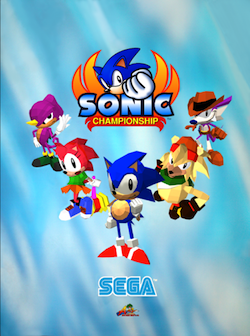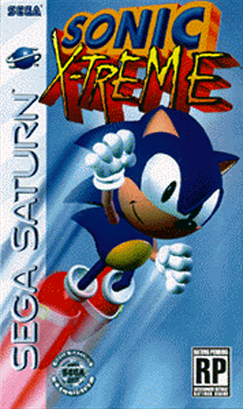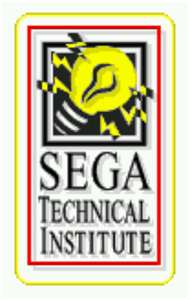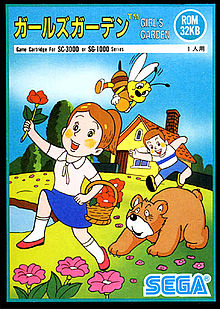Sonic Team is a video game developer owned by the Japanese video game company Sega as part of its Sega CS Research and Development No. 2 division. Sonic Team is best known for its namesake long-running Sonic the Hedgehog series and games such as Nights into Dreams and Phantasy Star Online.

Phantasy Star is a role-playing video game (RPG) developed by Sega and released for the Master System in 1987. One of the earliest Japanese RPGs for consoles, Phantasy Star tells the story of Alis on her journey to defeat the evil ruler of her star system, King Lassic, after her brother dies at his hands. She traverses between planets, gathering a party of fighters and collecting the items she needs to avenge her brother's death and return peace to the star system. The gameplay features traditional Japanese RPG elements including random encounters and experience points. All the characters have predefined personalities and abilities, a unique element compared to the customizable characters of other RPGs of the era.

The SG-1000 is a home video game console manufactured by Sega. It was Sega's first entry into the home video game hardware business. Developed in response to a downturn in arcades starting in 1982, the SG-1000 was created on the advice of Hayao Nakayama, president of Sega's Japanese arm, and was released on July 15, 1983, the same day that Nintendo released the Family Computer in Japan. It also had limited release in Australia and New Zealand.

Phantasy Star Online is an online role-playing game (RPG) developed by Sonic Team and published by Sega in 2000 for the Dreamcast. It was the first successful online RPG for game consoles; players adventure with up to three others over the internet to complete quests, collect items and fight enemies in real-time action RPG combat. The story is unrelated to previous games in the Phantasy Star series.

Sonic the Hedgehog is a 1991 platform game developed by Sonic Team and published by Sega for the Genesis/Mega Drive. It was released in North America on June 23 and in PAL regions and Japan the following month. Players control Sonic the Hedgehog, who can run at near supersonic speeds; Sonic sets out on a quest to defeat Dr. Robotnik, a scientist who has imprisoned animals in robots and seeks the powerful Chaos Emeralds. The gameplay involves collecting rings as a form of health, and a simple control scheme, with jumping and attacking controlled by a single button.

Sonic Adventure 2 is a 2001 platform game developed by Sonic Team USA and published by Sega for the Dreamcast. It features two good-vs-evil stories: Sonic the Hedgehog, Miles "Tails" Prower, and Knuckles the Echidna attempt to save the world, while Shadow the Hedgehog, Doctor Eggman, and Rouge the Bat attempt to conquer it. The stories are divided into three gameplay styles: fast-paced platforming for Sonic and Shadow, multidirectional shooting for Tails and Eggman, and action-adventure exploration for Knuckles and Rouge. Like previous Sonic the Hedgehog games, the player completes levels while collecting rings and defeating enemies. Outside the main gameplay, they can interact with Chao, a virtual pet, and compete in multiplayer battles.

Yuji Naka, credited in some games as YU2, is a former Japanese video game programmer, designer and producer. He is the co-creator of the Sonic the Hedgehog series and was the president of Sonic Team at Sega until his departure in 2006.

Sonic the Fighters, also known as Sonic Championship on arcade versions outside Japan, is a fighting game developed by Sega AM2. First released in 1996 in arcades on Sega's Model 2 arcade system, Sonic the Fighters pits players in one-on-one battles with a roster of characters from the Sonic the Hedgehog series.

Sonic Jam is a video game compilation developed by Sonic Team and published by Sega for the Sega Saturn. It was released in Japan in June 1997 and in North America and Europe the following August. It contains the four main Sonic the Hedgehog games released on the Sega Genesis: Sonic the Hedgehog (1991), Sonic the Hedgehog 2 (1992), Sonic the Hedgehog 3 (1994) and Sonic & Knuckles (1994). It also features a 3D environment, "Sonic World", which doubles as an interactive museum of Sonic the Hedgehog content.

Sega AM Research & Development No. 3, known as Hitmaker Co., Ltd. from 2000 to 2004, is a defunct division of Sega, a Japanese video game company. Established by 1993, AM3 was managed by Hisao Oguchi and developed a number of arcade games for Sega. Series introduced by AM3 include Virtual On, Sega Rally, Crazy Taxi, and Virtua Tennis. AM3's main focus was on arcade games until the release of the Dreamcast. Additionally, developers Tetsuya Mizuguchi and Kenji Sasaki developed Sega Rally Championship with AM3 before departing to form AM Annex, which later split into Sega AM9 and Sega AM5.

Sonic X-treme was a platform game developed by Sega Technical Institute from 1994 until its cancellation in 1996. It was planned as the first fully 3D Sonic the Hedgehog game, taking Sonic into the 3D era of video games, and the first original Sonic game for the Sega Saturn. The storyline followed Sonic on his journey to stop Dr. Robotnik from stealing six magic rings from Tiara Boobowski and her father. X-treme featured open levels rotating around a fixed center of gravity and, like previous Sonic games, featured collectible rings and fast-paced gameplay.

Sonic the Hedgehog is a 2006 platform game developed by Sonic Team and published by Sega. It was produced in commemoration of the Sonic series' 15th anniversary and intended as a reboot for seventh-generation video game consoles. Players control Sonic, Shadow, and the new character Silver, who battle Solaris, an ancient evil pursued by Doctor Eggman. Each playable character has his own campaign and abilities, and must complete levels, explore hub worlds and fight bosses to advance the story. In multiplayer modes, players can work cooperatively to collect Chaos Emeralds or race to the end of a level.

Sonic the Hedgehog is a video game series and media franchise created by the Japanese developers Yuji Naka, Naoto Ohshima, and Hirokazu Yasuhara for Sega. The franchise follows Sonic, an anthropomorphic blue hedgehog who battles the evil Doctor Eggman, a mad scientist. The main Sonic the Hedgehog games are platformers mostly developed by Sonic Team; other games, developed by various studios, include spin-offs in the racing, fighting, party and sports genres. The franchise also incorporates printed media, animations, feature films, and merchandise.

Sega Technical Institute (STI) was an American video game developer owned by Sega. Founded by the Atari veteran Mark Cerny in 1990, STI sought to combine elite Japanese developers, including the Sonic Team programmer Yuji Naka and his team, with new American talent. STI developed games for Sega Genesis, including several Sonic the Hedgehog games, before it was closed at the end of 1996.

Sonic the Hedgehog 2 is a 1992 platform game developed by Sega Technical Institute (STI) for the Sega Genesis. Players control Sonic as he attempts to stop Doctor Robotnik from stealing the Chaos Emeralds to power his space station. Like the first Sonic the Hedgehog (1991), players traverse side-scrolling levels at high speeds while collecting rings, defeating enemies, and fighting bosses. Sonic 2 introduces Sonic's sidekick Miles "Tails" Prower and features faster gameplay, larger levels, a multiplayer mode, and special stages featuring pre-rendered 3D graphics.

Black Belt is a beat 'em up video game developed and published by Sega for the Master System. The story follows Riki, a martial artist on a mission to save his girlfriend from his rival. Gameplay consists of a series of side-scrolling stages where the player battles waves of minor enemies and the occasional sub-boss. Stages culminate in more challenging boss encounters, each requiring the player to use a specific attack to win.
Prope Ltd. is a Japanese video game development studio founded by Sonic Team head Yuji Naka, along with 10 other former Sonic Team staff.

This is a list of development studios owned by Sega, a Japanese video game developer and publisher based in Tokyo, Japan. Accompanied with the list is their history of game development. Also included are the companies that Sega has acquired over the years. For a full list of games developed and published by Sega, see List of Sega video games, List of Sega mobile games and List of Sega arcade games.

Sega Hard Girls is a Japanese multimedia project produced as a collaboration between ASCII Media Works' Dengeki Bunko imprint and video game company Sega. The project re-imagines various Sega video game consoles as anthropomorphized goddesses who appear all over modern Japan. The project has inspired a light novel series written by Tōru Shiwasu with illustrations by Kei, which was serialized in ASCII Media Works' Dengeki Bunko Magazine between 2013 and 2014, and an anime television series adaptation titled Hi-sCoool! SeHa Girls by TMS Entertainment, which aired in Japan between October and December 2014. A crossover video game with Idea Factory's Hyperdimension Neptunia franchise, Superdimension Neptune VS Sega Hard Girls, was released for the PlayStation Vita in Japan in November 2015, and in North America and Europe in October 2016.

















